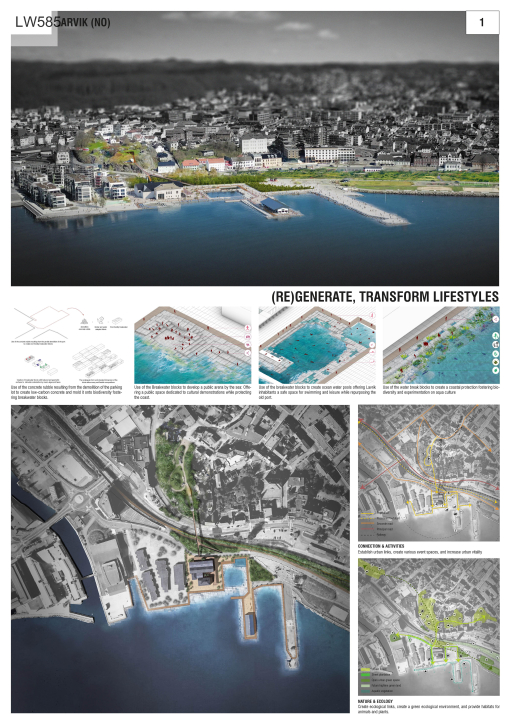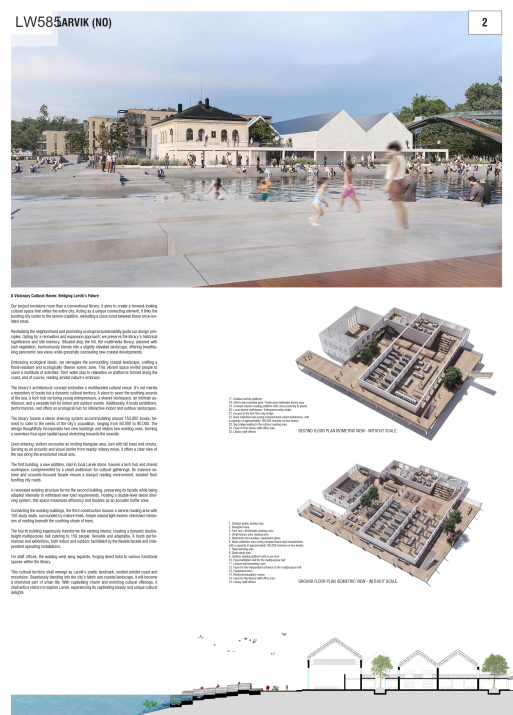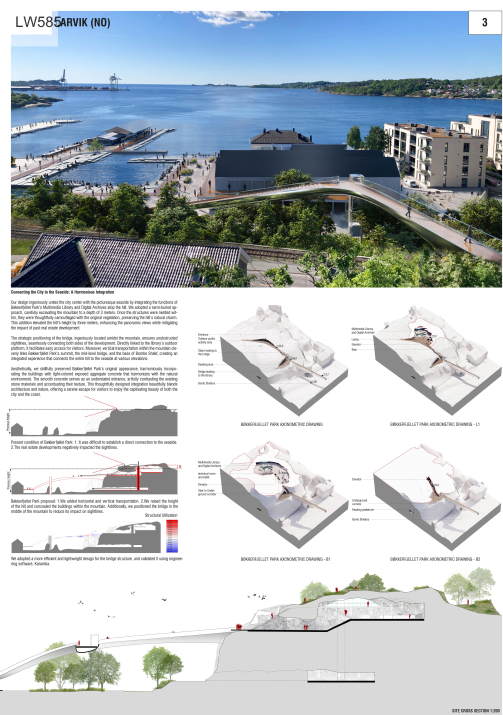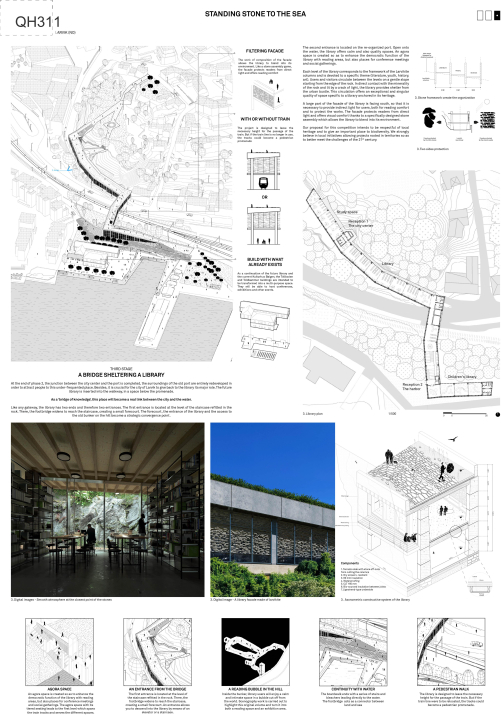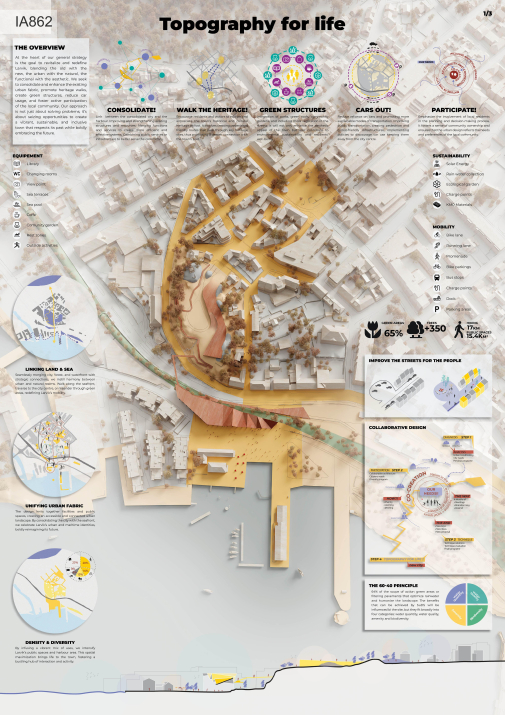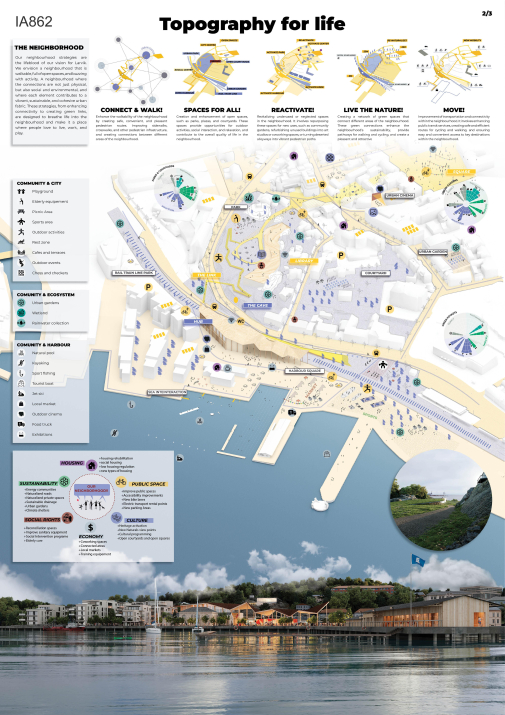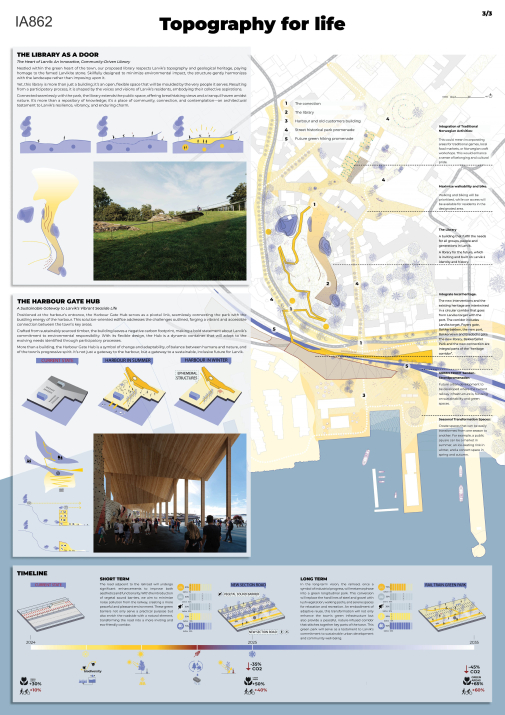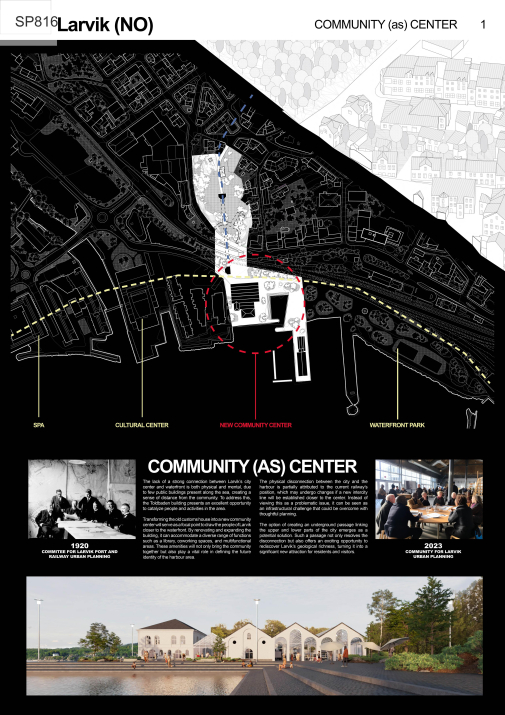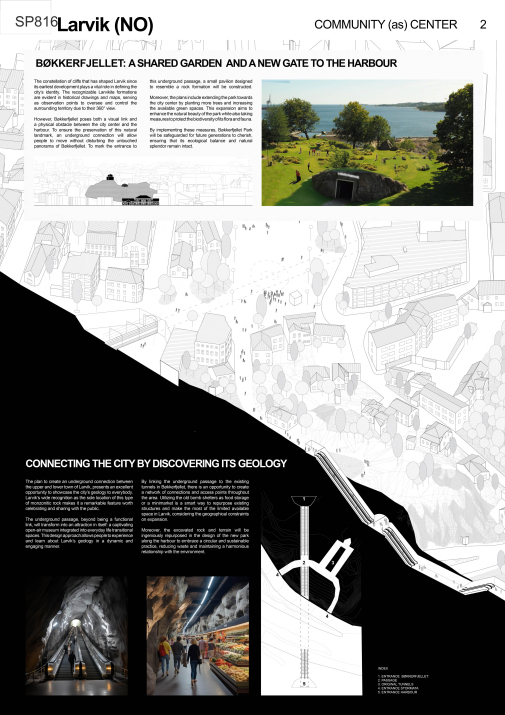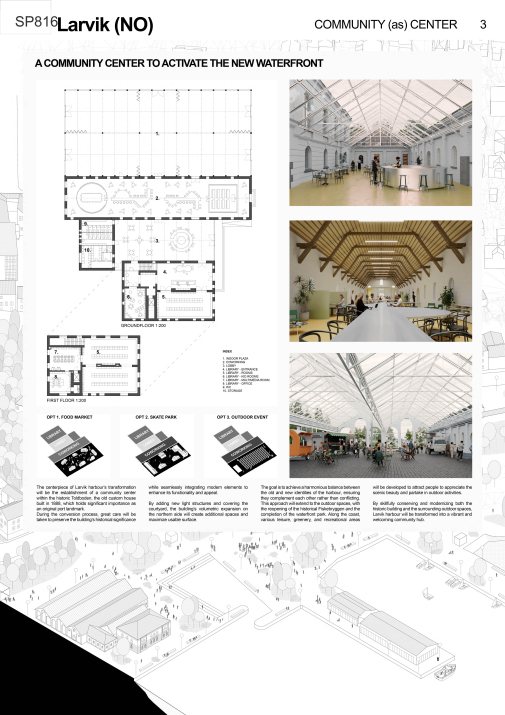The results for Larvik are here
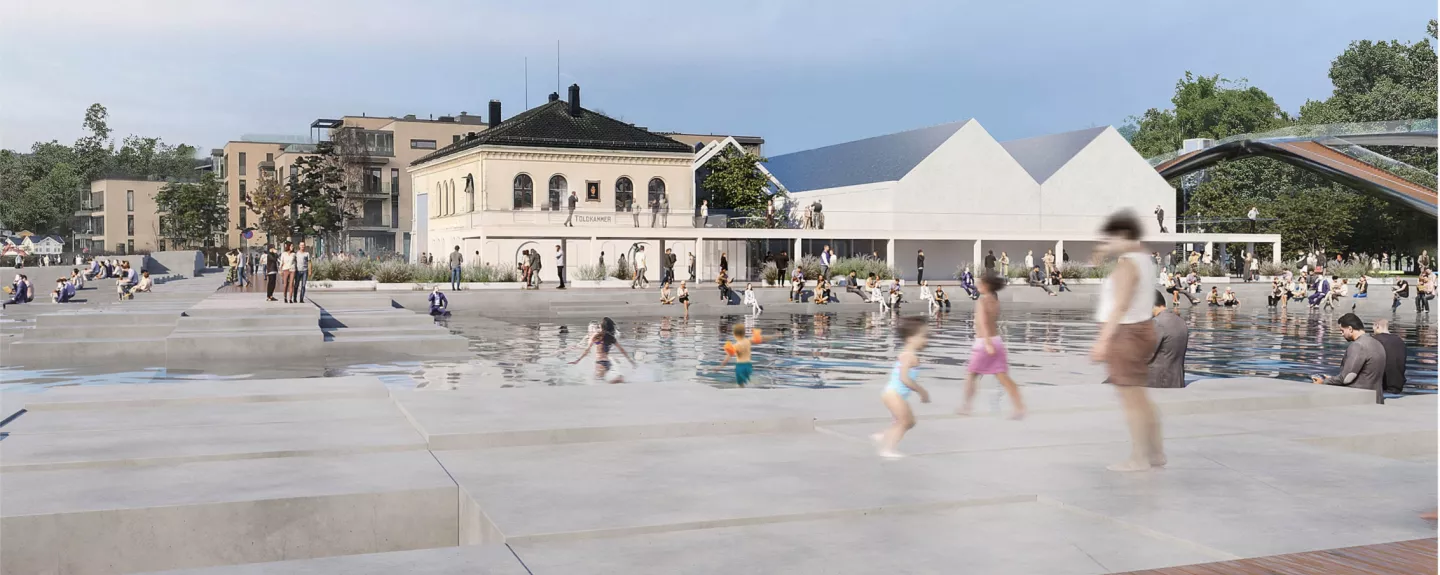
"(Re)generate" by won the competition for connecting the harbor and the city centre in Larvik.
General Remarks by the jury
In Larvik, the town center and the harbor are separated by a busy road, a railway line, and challenging topography. The task outlined in the brief was to create a connection that would unite the center and the seafront.
The jury would like to thank all participants for their entries. These entries clearly reflect a dedicated group seeking to solve Larvik's connectivity challenge. Larvik received a total of 19 proposals, exhibiting a wide array of ideas. Four of these entries were short-listed for consideration.
While many proposals concentrated solely on the crossing itself, the jury wished to see better understanding of how everything around the area connects. Different roads encircle the area, each serving distinct roles and functions, which should have been integrated into a comprehensive and analytical approach. Specifically, greater consideration should have been given to facilitating access to the harbor from the train station for people arriving in Larvik via train, as the station adjoins the study site. Ideally, the proposed crossing should be easily accessible from the train station.
Nonetheless, the jury found numerous intriguing ideas and proposals that were thoroughly evaluated. It is really important that the upcoming plans strongly prioritize linking Larvik's city center with the harbor, strengthening the city center, and it is the jury's opinion that the winning project offers a robust concept that can fulfill this task.
Download the full report for feedback on all projects
Team
TIAN LI (FR), architect
Ons LARGUECH (TN), architect
Zihao WANG (CN), architect
Shan JIANG (CN), landscape architect
Ala Rassaa (FR), architect
Jury remarks
The proposal creates a strong link between the town, Bøkkerfjellet and the seafront. It suggests a variety of means of how to connect the strongly separated parts of town through a row of physical, programmatic and visual interventions, which should use circular economy as a material resource. The fragmentary approach to the task was considered by the jury to be an appropriate response to an equally fragmented environment, as well as a valuable tool for dealing with a development process full of uncertainties.
The proposal suggests a multimedia library and digital archives dug inside Bokkerfjellet and a multi-function cultural centre down by the seashore. These two focal points should be interconnected by the visually strongest feature of the proposal, the bridge.
The multimedia library is suggested to be built inside Bøkkerfjellet in order to be a part of the connecting route. The vertical connection is a good addition, although a possibly fairly demanding one to make tempting to use on street level.The new bridge has a smooth design and it looks inviting to use in its human scale. Lowering the bridge level is a clever solution to make it more inviting and closer to street scale.
On the other hand, the shoreline is dominated by two characteristic features – the cultural centre including a library and the sculpted access to the Fjord. Taking water as a part of the program is a clever and natural solution to avoid creating a direct borderline where the sea meets the land. Breaking that borderline into a built marine landscape is an inviting gesture to the inhabitants too. The redesign of the shoreline is based on the idea of partly recycling the material from the old car park and redesigning it into the seapool structures.
The project proves that the site is suitable for a new cultural activity. It could be a library, a cultural centre and accommodate commercial space too. The idea of keeping the old Tollboden building and adding new parts to it works well and gives the library a special character.
Comments for further development of the proposal:
In an urban sense the proposal is flexible for further elaboration and programming. The specific functions may easily be specified or partly reprogrammed when needed. The bridge and the seapool are the main characteristics of the proposal. The rest can be developed further according to future programs. The vertical connection through Bokkerfjellet must be carefully designed to be a pleasant part of the routes. The study of the shore area proves that there are good opportunities to build something inviting by the shoreline for the people. If it's not a library, the proposal gives other ideas based on the marine location. Making the marine wildlife and research visible at the pool area is a beautiful idea worth researching and programming more.
The proposal was also the “Folkestemmen’s” (audience) favorite, which gives a solid basis for further development together with all stakeholders. The jury notes that programming and investments in phases need to be taken carefully into account in the process of further development, for what (re)Generate seems to be the adequate project.
Team:
ALEXANDRE BAILLEUX (FR), architect
Warren Louis-Marie (FR), architect
Noémie Pages (FR), architect
Jury remarks:
The project aims to connect Bøkkerfjellet and the harbor via a promenade. It suggests building a library within this promenade, featuring a walkway on top. The structure can be constructed in phases, using local materials. A part of the library will be inside the hill's bunker. The promenade ends at the harbor, with stairs leading to the water.
'Standing Stone to the Sea' impressed the jury with its detailed plans and drawings, showing thorough consideration. It focuses on Larvik's features, such as the hill's view of the fjord, a welcoming library atmosphere, wildlife considerations like lizards using the crossing, and the use of local materials. The main concern revolves around the project's lack of flexibility, given its status as a megastructure with fixed connections at both ends. The project could have benefited from focusing less on the details and materiality of the structure and more effort on a sensitive adaptation to the landscape and better resolved meetings with surrounding urban spaces. Additionally, the proposed phases seem unrealistic and more rhetoric.
The jury appreciates the project's unique concept and how it connects different parts of the city. It's a bold move that could revitalize Larvik by linking the city center to the sea. At best it could characterize the arrival view into Larvik. The project's idea of using the library as a connector is seen as innovative and forward-thinking in urban development.
Team:
Gustavo Figueira Serrano (ES), architect
Itarte Pérez Álvaro (ES), architect
Pombar Guillán Javier (ES), architect
Díaz Mosqueira Diego (ES), architect
Álvarez Vázquez Alba (ES), architect
González Verdía Jimena (ES), architect
Jury Remarks:
Topography for life impresses with a strategy for the whole study site. The proposal outlines comprehensive pedestrian-friendly street refurbishment and couples it with light and easily executable interventions around the streets. The jury appreciates that the project places the library and programs on the mountain, showcasing public spaces, and strengthening Larviks city centre. However, the project falls short due to certain ambiguities. The proposed winding path lacks clarity in its ultimate destination, and the harbor building appears more as a landmark than a highly functional structure. The project introduces several small ideas, but the main aspects require more articulate development for a stronger impact. Topography for life is a reminder to look beyond the explicit competition guidelines when attempting to revitalize the centre of Larvik.Team:
Barbara Mazza (BE), architect
Claudio Cortese (BE), architect
Jury Remarks:
The jury highly appreciated the transformation of the historic buildings, which successfully combined preservation and reinterpretation with innovative additions. The introduction of light structures were noted as sensitive and commendable design elements, considering energy and climate factors, creating semi-climatized spaces bridging the gap between indoor and outdoor areas. This approach effectively preserves and revitalizes the cultural heritage in an intriguing way.
The proposed escalator as a solution for improving connectivity received commendation for its intelligent and efficient urban approach. It skillfully tapped into the underground potential and made creative use of the bunkers. However, concerns were expressed regarding the costs of implementing this structure, limited population in Larvik and whether this approach would be regarded as safe at night.
